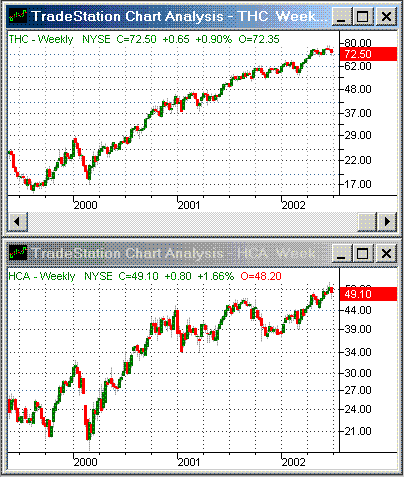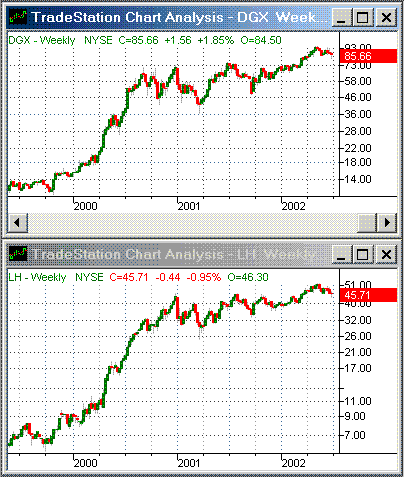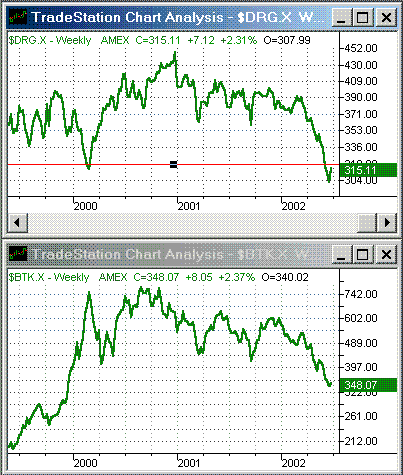
HOT TOPICS LIST
- Strategies
- Stocks
- Buy
- Investing
- Brokers
- Psychology
- Interviews
- Accumulate
- Sell
- Hold
- Spotlight
- Websites
- Candlestick Corner
- Gold & Metals
- Options Trading
LIST OF TOPICS
FOCUS ON
Injecting Hospital Stocks Into Your Portfolio
07/09/02 03:04:18 PM PSTby David Penn
The smallest industry in health care may feature the sector's best buys in stocks.
| While genome projects and elusive cancer cures keep biotechnology stocks firmly in investors' minds and the travails of the big pharmaceutical companies put ulcers in investors' stomachs, many of the larger health-care facilities' stocks have advanced strongly over the past year. More important, after a brief correction in June, many of these stocks look to be on the move back up again. One of the most fundamental ways to look at the stocks in a given industry is simply to ask: "Why would these stocks increase (or decrease) in value? Is there a common-sense reason that can explain what the stocks seem to be saying?" Fortunately, as sure as there are reasons that pharmaceutical stocks — particularly those of the larger companies — remain under pressure, there are equally obvious reasons why hospital stocks might outperform others in the health-care sector, if not outperform the stock market in general. As Sam Stovall, chief sector strategist for Standard & Poor's, wrote in BusinessWeek earlier this year, these reasons include both increased admissions (greater demand) and more money by way of more effective payment collections and a bigger cut from Medicare. Michael Brush, writing for MSN's MoneyCentral, puts it even more bluntly: "Hospitals have the power to increase prices once again." And the fact that the lion's share of these prices is increasingly borne by company medical plans and government programs such as Medicare means that many — though by no means all — are relatively sheltered from the full impact of these rising prices. Nevertheless, A.J. Rice, Merrill Lynch's health-care services analyst, notes that "in spite of the severe volatility caused by 'Clinton-Care' in 1993" (the ill-fated national health plan briefly championed by then-First Lady Hillary Clinton), hospitals in particular have been solid investments for the past decade. And with growing volumes of patients (thanks to aging baby boomers) and the way that health-care facilities have grown — through consolidations, mergers, and by stealing market share from nonprofit hospitals (see Jonathan Cohn's excellent piece in The New Republic, "Sick: Why America Is Losing Its Best Hospitals) — the financial fortunes of the biggest health-care facilities are, for the foreseeable future, bright indeed.
TAKING TWO OFF THE TOPBefore you search for hidden gems among hospital stocks, it is worth looking at the largest health-care facilities corporations in the market (in terms of capitalization). No less a stock trader than Jesse Livermore championed the notion of looking to the strongest stocks in a given industry or sector for the best sense of how that industry or sector is performing. In the case of health-care facilities, two corporations — HCA, Inc. (HCA), and Tenet Healthcare Corp. (THC) — sit at the top of the market in terms of market capitalization. How do they stack up in terms of market performance? With more than $23 billion in market capitalization each, both HCA and Tenet Healthcare are the gorillas of the health-care facilities industry (Figure 1). A three-year look at their respective performance shows that the stock of these companies has appreciated well; since 2000, Tenet Healthcare is up more than 140% and HCA is up just shy of 50%. In 2002 alone, THC has appreciated by 11% and HCA by more than 25%. Not bad, in a year when the S&P 500 has dropped more than 15%.
Figure 1: The two biggest hospital corporations, HCA and Tenet Healthcare, have been solid health-care stocks since 2000.
One of the more bullish signs for these hospital corporations comes from HCA, which has only recently bested its 2001 high of 47.28. This is significant insofar as HCA looked dangerously close to forming a head and shoulders top (a bearish reversal chart pattern) that stretched back to late 2000. If any short-term correction in HCA finds support on the 2001 high, then further advances should be in the cards. Even THC, which has not corrected significantly since the 2000 decline, may be able to continue to gain ground, inasmuch as its advance has moderated (if you consider beating the S&P 500 by more than 20% moderate!) and does not yet display any of the parabolic tendencies that often herald the end of bull markets. Just under the big two are companies with single-digit, billion-dollar market capitalizations that have performed even better than their bigger peers over the past three years (Figure 2). Laboratory Corporation of America (LH) traded around $9 at the beginning of 2000; it is now up over 400%, with a year-to-date return of more than 14%. Quest Diagnostics (DGX) traded near $14 early in 2000. DGX is now up a whopping 500% three years later, with a year-to-date return of more than 17%.
Figure 2: "Big" was good for hospital stocks in the new millennium, but "not-so-big" was even better, as these hospital stocks attest.
GROWING AGAINST THE GRAINIt is interesting to look at the health-care sector's performance against the S&P 500 because, in some ways, this comparison only underscores the relative strength of the health-care facilities industry within the health-care sector compared to other industries such as biotechnology and pharmaceuticals. Note how, in 2000, when the S&P 500 topped and was slowly beginning to decline, the S&P health-care index ($HCX.X) broke out on the upside, finishing the year up 43% compared to the S&P 500's 11% decline (Figure 3). In 2001, when the S&P 500 began to fall in earnest, the S&P health-care index managed to hold its own, finishing the year only slightly down compared to the broader market, which was down a little more than 13%.
Figure 3: The S&P health-care index shows health care advancing while the broader market formed a top. When the S&P 500 began declining, health care held its own until 2002.
Note, in addition, how both the drug and biotech indexes have dropped beneath their year-2000 lows (Figure 4). Both indexes appear to be making a mild attempt to rally at the end of the second quarter of 2002 but, for now, the lows of 2000 loom as minor resistance to any rally.
Figure 4: The AMEX pharmaceuticals and biotechnology indexes show how these stocks stagnated after a strong 2000 and 1999, respectively.
Looking to 2002, we see an S&P 500 that is in an even worse decline than in the previous two years (down more than 14% year to date). By this time, the S&P health-care index succumbed to the overall bearishness, down by about the same amount. However, what is promising about the health-care sector in general is the way the S&P health-care index appears to have found support on the lows established in the first quarter of 2000, just north of 314. At this point, it is worth noting that the S&P health-care index has retraced two and a half years' worth of advances. Should this support hold, however, the likelihood of a rally in health-care stocks would be greatly increased. And if health care advances, will hospitals be far behind?
David Penn may be reached at DPenn@Traders.com.
RELATED READINGCohn, Jonathan [2001]. "Sick: Why America Is Losing Its Best Hospitals," The New Republic: May 28.Hartle, Thom [1996]. "Top Down Investing With S&P's Sam Stovall," interview, Technical Analysis of Stocks & Commodities, Volume 14: March. LeFèvre, Edwin [1994]. Reminiscences Of A Stock Operator, John Wiley & Sons. Originally published in 1923. Livermore, Jesse [1991]. How To Trade In Stocks, Traders Press: Greenville, SC. Originally published in 1940. Stovall, Sam [2002]. "After A June Swoon," BusinessWeek: July.
Current and past articles from Working Money, The Investors' Magazine, can be found at Working-Money.com.
|
Technical Writer for Technical Analysis of STOCKS & COMMODITIES magazine, Working-Money.com, and Traders.com Advantage.
| Title: | Traders.com Technical Writer |
| Company: | Technical Analysis, Inc. |
| Address: | 4757 California Avenue SW |
| Seattle, WA 98116 | |
| Phone # for sales: | 206 938 0570 |
| Fax: | 206 938 1307 |
| Website: | www.traders.com |
| E-mail address: | DPenn@traders.com |
Traders' Resource Links | |
| Charting the Stock Market: The Wyckoff Method -- Books | |
| Working-Money.com -- Online Trading Services | |
| Traders.com Advantage -- Online Trading Services | |
| Technical Analysis of Stocks & Commodities -- Publications and Newsletters | |
| Working Money, at Working-Money.com -- Publications and Newsletters | |
| Traders.com Advantage -- Publications and Newsletters | |
| Professional Traders Starter Kit -- Software | |
PRINT THIS ARTICLE

|

Request Information From Our Sponsors
- StockCharts.com, Inc.
- Candle Patterns
- Candlestick Charting Explained
- Intermarket Technical Analysis
- John Murphy on Chart Analysis
- John Murphy's Chart Pattern Recognition
- John Murphy's Market Message
- MurphyExplainsMarketAnalysis-Intermarket Analysis
- MurphyExplainsMarketAnalysis-Visual Analysis
- StockCharts.com
- Technical Analysis of the Financial Markets
- The Visual Investor
- VectorVest, Inc.
- Executive Premier Workshop
- One-Day Options Course
- OptionsPro
- Retirement Income Workshop
- Sure-Fire Trading Systems (VectorVest, Inc.)
- Trading as a Business Workshop
- VectorVest 7 EOD
- VectorVest 7 RealTime/IntraDay
- VectorVest AutoTester
- VectorVest Educational Services
- VectorVest OnLine
- VectorVest Options Analyzer
- VectorVest ProGraphics v6.0
- VectorVest ProTrader 7
- VectorVest RealTime Derby Tool
- VectorVest Simulator
- VectorVest Variator
- VectorVest Watchdog




